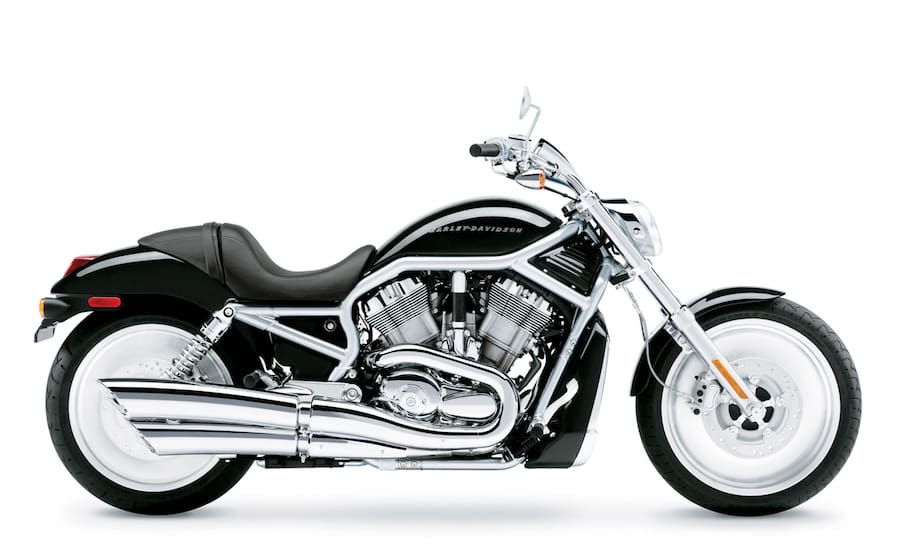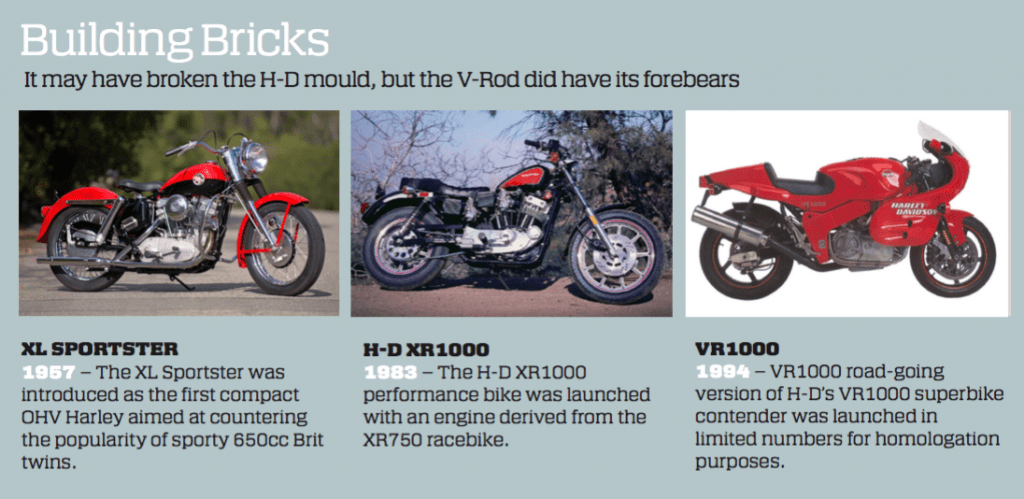Harley-Davidson broke serious new ground with the V-Rod power-cruiser – a cutting edge, new-era bike for the new millennium.
The factory’s usual fondness for multi-letter tags sees it officially labelled the VRSCA. This apparently translates as: V-twin Racing Street Custom (A = first version).
The VRSCA is long and low and cleanly styled, with much gleaming polished alloy and silver paint – H-D called it the ‘anodised’ look. Although the perimeter frame looks like alloy it’s actually fabricated from steel tubing. It rolls on Fatboy-inspired disc wheels and is suspended on a robust, raked-out, 49mm fork and a lovely cast-alloy swingarm supported by twin shocks. The exposed swingarm-pivot nut looks oddly out of place among all the glitter. Very un-Harley, that. Then, when you look at powertrain details, you realise just how seriously un-Harley the V-Rod is.
In 2001 this Harley-Davidson’s liquid-cooled, 60º, DOHC, four-valve, 1130cc ‘Revolution’ engine represented a giant and heroic leap for Milwaukee’s revered Motor Company away from its signature air-cooled, 45º, two-valve, pushrod units. The scale of the exercise is underlined by H-D’s use of German design expertise – Porsche for engine-design detail and Getrag for gearbox detail. A big change in the transmission department is a gear primary drive instead of H-D’s trademark primary chain.
We’ll consider the first two 1130cc-engine versions here – the VRSCA in silver and the VRSCB in black. Various other models followed with a 1250cc engine, including the Destroyer, a ‘competition only’ pure drag racer.
Settled in the very low (660mm) and comfortable seat, gazing over the analogue instrument cluster and the raked-out front end of the long, low chassis, there’s definitely a drag-strip feel. The reach to the forward-mount footrests makes the V-Rod a stretch too far for some shorter folk.
Its hefty 270kg dry weight is carried low enough to not be a real issue.
The design sophistication of the powertrain is immediately obvious on the road. The high-tech 60º motor is way smoother than anything else wearing H-D badges. The EFI’s fuelling is spot on. Vibration is minimal. Its broad spread of torque is accessed happily through the five-speed gearbox with progressive responses from throttle and clutch alike. While clutch action is fairly heavy, the gearshift is slick and accurate.
Suspension performance and handling deserves praise for dealing with bumps effectively, delivering high-speed stability and cornering predictably and accurately. The qualifications are that it tends to flop into low-speed corners due to the 38º rake. Predictably, the long (1715mm) wheelbase enhances stability while slowing steering responses. Although cornering clearance is better than usual cruiser standards, it ultimately sets the limits for lean angle and cornering speed, particularly on fast right-handers when you deck the lower muffler.
The engine’s performance around 3000rpm in traffic is smooth and relaxed, before you break free and ride the rising torque-wave toward 5000rpm. Then, about where most H-D ‘Big Twins’ are calling it quits, the V-Rod surges urgently on, in a spine-tingling rush to 8000rpm or more. In this mode you’re enjoying serious performance – no surprise considering that the V-Rod’s 86kW (115hp) max power was a match for the Italian master blaster of the day, the Ducati 996.
Three 292mm four-pot brake discs rein in the bike’s performance effectively.
The small underseat-mounted 14-litre tank limits the safe touring range to about 200km.
Obviously the route H-D followed to produce this genuine big-bore performance bike produced a result closer to a Yamaha VMax than a Suzuki Hayabusa. Although straight-line bitumen burning comes naturally to a V-Rod, it’s far more than a one-trick pony. As well it’s a showcase for engineering excellence, a reliable motorcycle to own and, make no mistake, it’s one helluva hot Harley to ride.
PRICE GUIDE
New Price
VRSCA – $30,500 VRSCB – $28,995
Second-Hand
$11,200 – $20,200

WHAT TO LOOK FOR
Excellent engineering and manufacturing quality contribute to the V-Rod’s remarkable reliability record. I’m unaware of any consistent issues beyond reports of some fuel-gauge malfunctions. Look for corrosion of alloy and plated components due to neglect.
To avoid big dollar drive-belt replacement, costs check that belt and pulleys are in good nick. They’re apparently good for 160,000km, but damage from trapped stones can cause premature failure.
Then it’s down to allowing for tyres, brake pads, steering head bearings and brake rotors that might soon need replacing.

SERVICE HISTORY
Given proper servicing, you can expect a long trouble-free life from a V-Rod. Reasonable access to engine-oil drain plug and filter allows DIY owners to handle routine servicing. Top-end engine work requires removal of the airbox and associated items.
With valve shims instead of H-D’s usual hydraulic lifters, valve-clearance adjustments are costly. Not only must the camshafts come out, the engine has to be partly unbolted from its mountings and lowered to give proper access.
Service intervals are 8000km for oil and filter, 16,000km for sparkplugs, and 24,000km for valve clearances.
WORDS ROB BLACKBOURNE
PHOTOGRAPHY AMCN ARCHIVES











